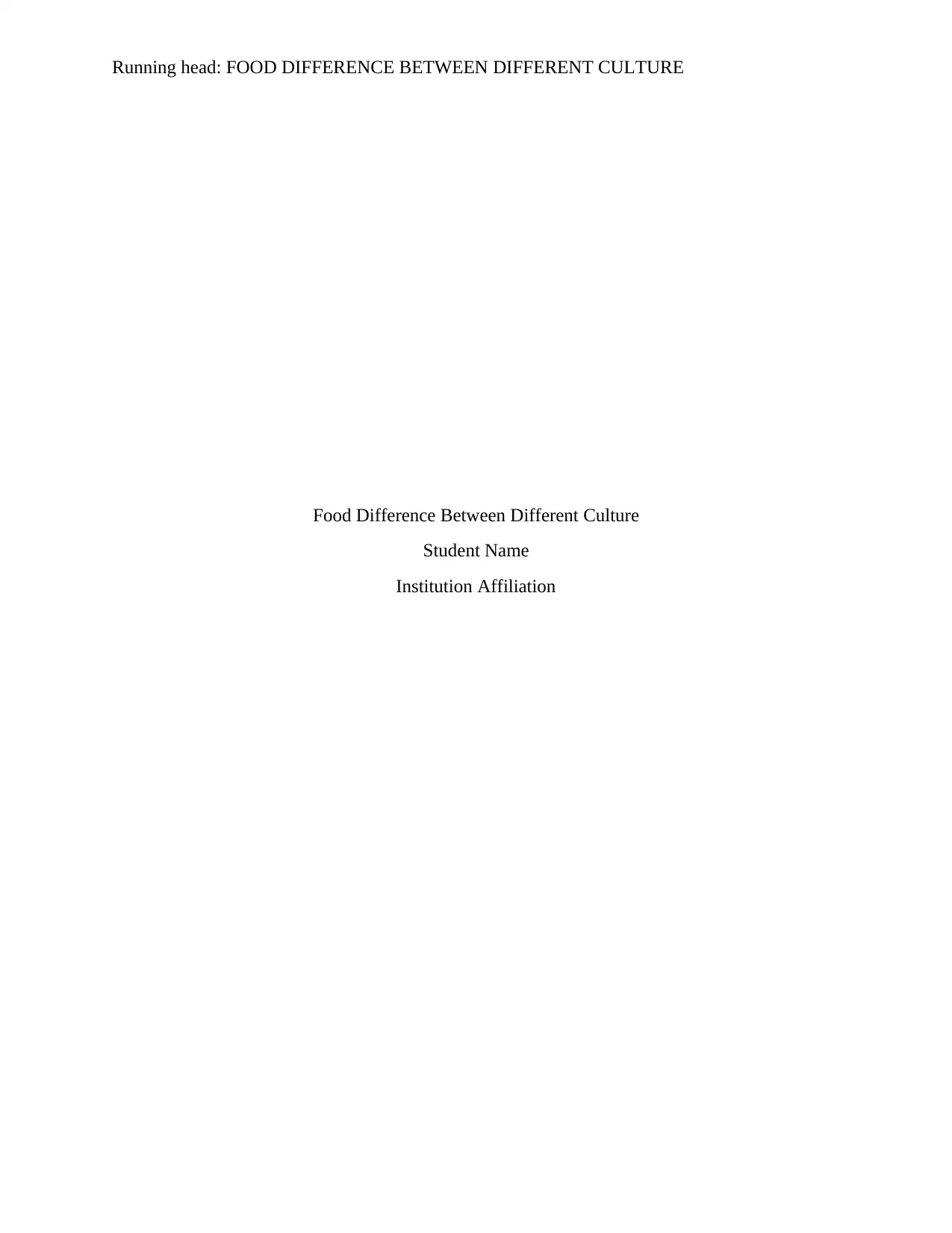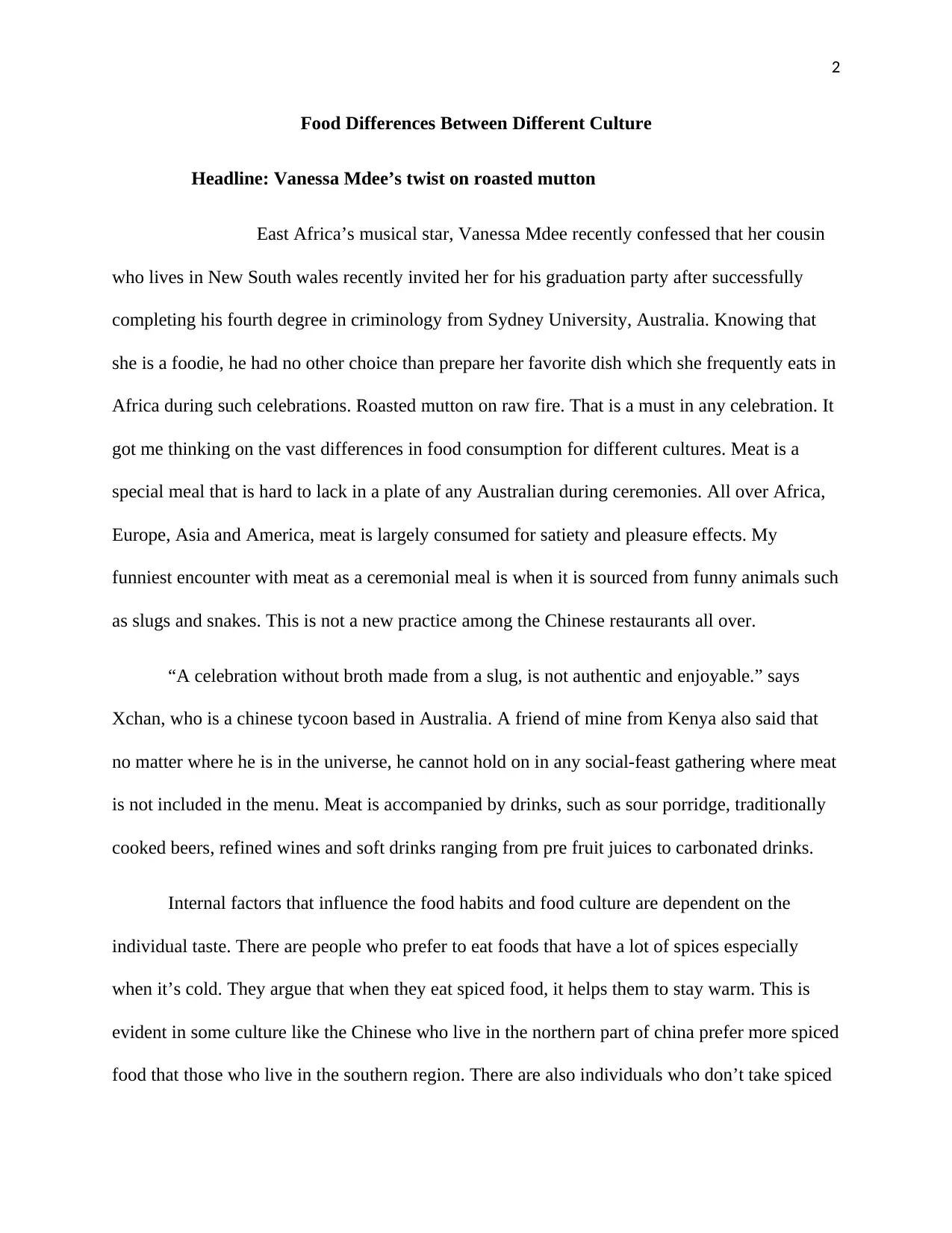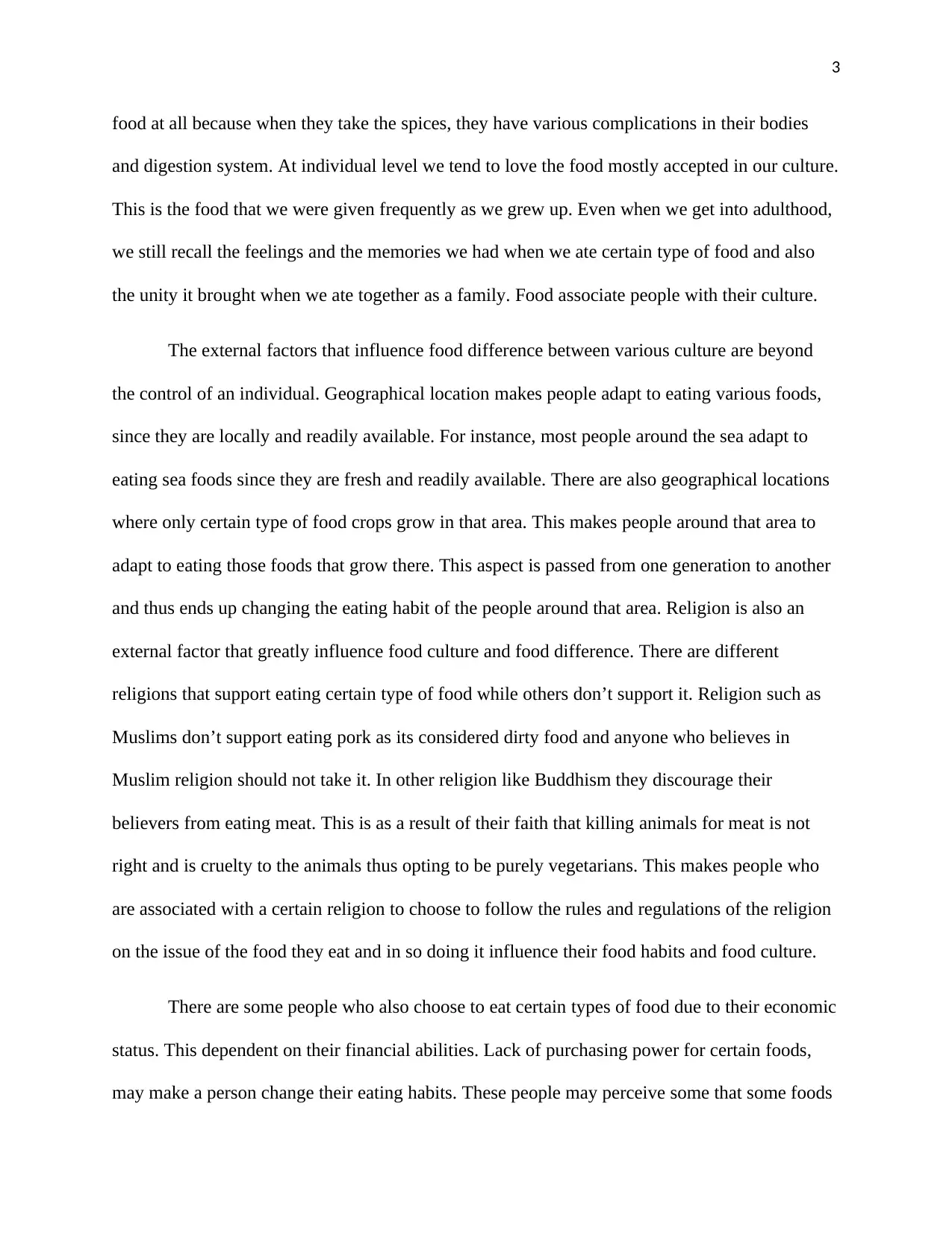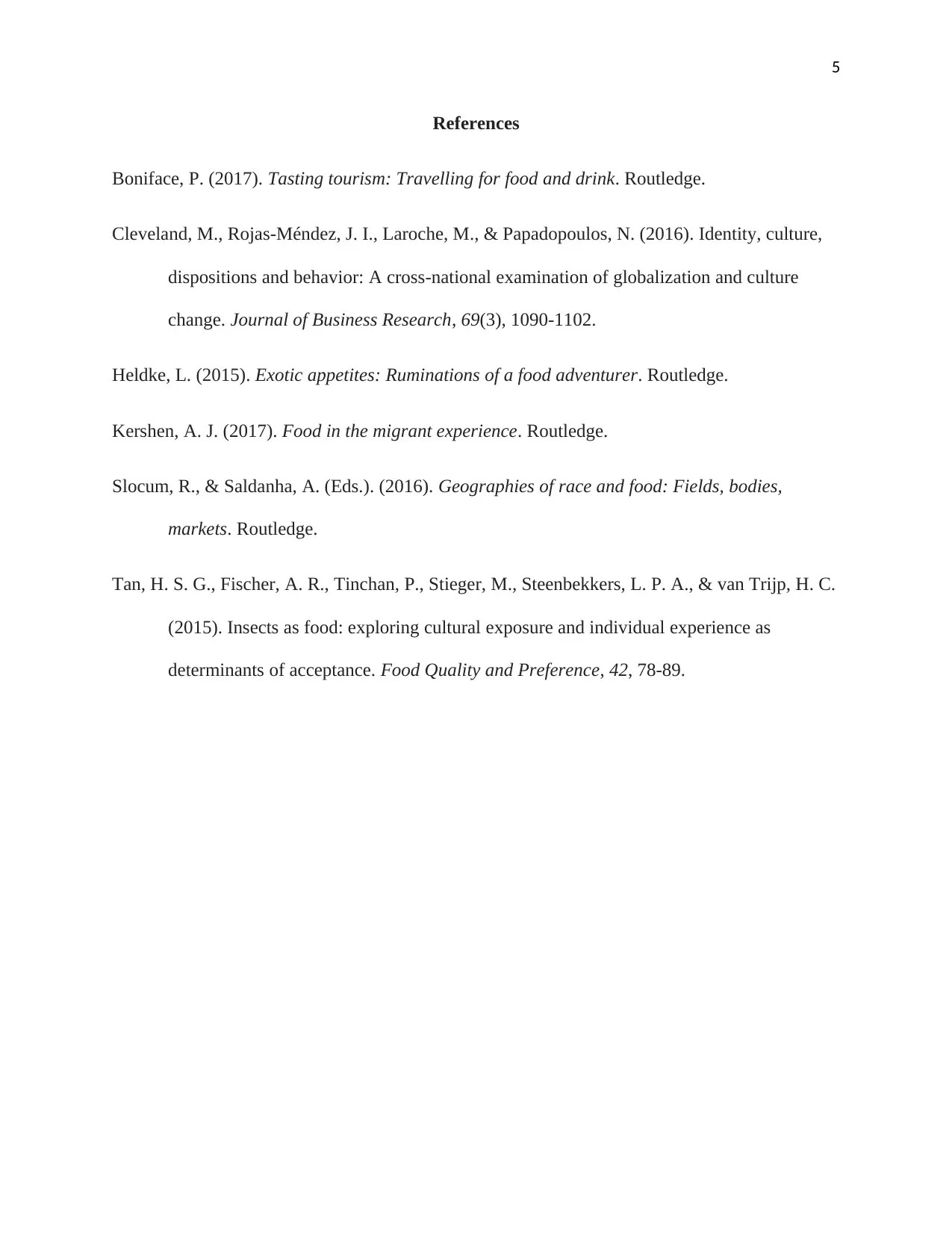A Study of Food Differences Between Different Cultures
VerifiedAdded on 2022/10/09
|5
|1024
|30
Essay
AI Summary
This essay explores the multifaceted differences in food consumption across various cultures, highlighting the influences of internal factors like individual taste and cultural upbringing, as well as external factors such as geographical location, religion, and economic status. It discusses how geographical availability of foods, religious dietary restrictions, and economic purchasing power shape food habits and cultural norms. The essay references various studies to support its analysis of how these factors interact to create distinct food cultures around the world, emphasizing the role of food in cultural identity and social gatherings. The essay concludes by noting that these elements operate cohesively to produce the diverse range of food differences observed between cultures.

Running head: FOOD DIFFERENCE BETWEEN DIFFERENT CULTURE
Food Difference Between Different Culture
Student Name
Institution Affiliation
Food Difference Between Different Culture
Student Name
Institution Affiliation
Paraphrase This Document
Need a fresh take? Get an instant paraphrase of this document with our AI Paraphraser

2
Food Differences Between Different Culture
Headline: Vanessa Mdee’s twist on roasted mutton
East Africa’s musical star, Vanessa Mdee recently confessed that her cousin
who lives in New South wales recently invited her for his graduation party after successfully
completing his fourth degree in criminology from Sydney University, Australia. Knowing that
she is a foodie, he had no other choice than prepare her favorite dish which she frequently eats in
Africa during such celebrations. Roasted mutton on raw fire. That is a must in any celebration. It
got me thinking on the vast differences in food consumption for different cultures. Meat is a
special meal that is hard to lack in a plate of any Australian during ceremonies. All over Africa,
Europe, Asia and America, meat is largely consumed for satiety and pleasure effects. My
funniest encounter with meat as a ceremonial meal is when it is sourced from funny animals such
as slugs and snakes. This is not a new practice among the Chinese restaurants all over.
“A celebration without broth made from a slug, is not authentic and enjoyable.” says
Xchan, who is a chinese tycoon based in Australia. A friend of mine from Kenya also said that
no matter where he is in the universe, he cannot hold on in any social-feast gathering where meat
is not included in the menu. Meat is accompanied by drinks, such as sour porridge, traditionally
cooked beers, refined wines and soft drinks ranging from pre fruit juices to carbonated drinks.
Internal factors that influence the food habits and food culture are dependent on the
individual taste. There are people who prefer to eat foods that have a lot of spices especially
when it’s cold. They argue that when they eat spiced food, it helps them to stay warm. This is
evident in some culture like the Chinese who live in the northern part of china prefer more spiced
food that those who live in the southern region. There are also individuals who don’t take spiced
Food Differences Between Different Culture
Headline: Vanessa Mdee’s twist on roasted mutton
East Africa’s musical star, Vanessa Mdee recently confessed that her cousin
who lives in New South wales recently invited her for his graduation party after successfully
completing his fourth degree in criminology from Sydney University, Australia. Knowing that
she is a foodie, he had no other choice than prepare her favorite dish which she frequently eats in
Africa during such celebrations. Roasted mutton on raw fire. That is a must in any celebration. It
got me thinking on the vast differences in food consumption for different cultures. Meat is a
special meal that is hard to lack in a plate of any Australian during ceremonies. All over Africa,
Europe, Asia and America, meat is largely consumed for satiety and pleasure effects. My
funniest encounter with meat as a ceremonial meal is when it is sourced from funny animals such
as slugs and snakes. This is not a new practice among the Chinese restaurants all over.
“A celebration without broth made from a slug, is not authentic and enjoyable.” says
Xchan, who is a chinese tycoon based in Australia. A friend of mine from Kenya also said that
no matter where he is in the universe, he cannot hold on in any social-feast gathering where meat
is not included in the menu. Meat is accompanied by drinks, such as sour porridge, traditionally
cooked beers, refined wines and soft drinks ranging from pre fruit juices to carbonated drinks.
Internal factors that influence the food habits and food culture are dependent on the
individual taste. There are people who prefer to eat foods that have a lot of spices especially
when it’s cold. They argue that when they eat spiced food, it helps them to stay warm. This is
evident in some culture like the Chinese who live in the northern part of china prefer more spiced
food that those who live in the southern region. There are also individuals who don’t take spiced

3
food at all because when they take the spices, they have various complications in their bodies
and digestion system. At individual level we tend to love the food mostly accepted in our culture.
This is the food that we were given frequently as we grew up. Even when we get into adulthood,
we still recall the feelings and the memories we had when we ate certain type of food and also
the unity it brought when we ate together as a family. Food associate people with their culture.
The external factors that influence food difference between various culture are beyond
the control of an individual. Geographical location makes people adapt to eating various foods,
since they are locally and readily available. For instance, most people around the sea adapt to
eating sea foods since they are fresh and readily available. There are also geographical locations
where only certain type of food crops grow in that area. This makes people around that area to
adapt to eating those foods that grow there. This aspect is passed from one generation to another
and thus ends up changing the eating habit of the people around that area. Religion is also an
external factor that greatly influence food culture and food difference. There are different
religions that support eating certain type of food while others don’t support it. Religion such as
Muslims don’t support eating pork as its considered dirty food and anyone who believes in
Muslim religion should not take it. In other religion like Buddhism they discourage their
believers from eating meat. This is as a result of their faith that killing animals for meat is not
right and is cruelty to the animals thus opting to be purely vegetarians. This makes people who
are associated with a certain religion to choose to follow the rules and regulations of the religion
on the issue of the food they eat and in so doing it influence their food habits and food culture.
There are some people who also choose to eat certain types of food due to their economic
status. This dependent on their financial abilities. Lack of purchasing power for certain foods,
may make a person change their eating habits. These people may perceive some that some foods
food at all because when they take the spices, they have various complications in their bodies
and digestion system. At individual level we tend to love the food mostly accepted in our culture.
This is the food that we were given frequently as we grew up. Even when we get into adulthood,
we still recall the feelings and the memories we had when we ate certain type of food and also
the unity it brought when we ate together as a family. Food associate people with their culture.
The external factors that influence food difference between various culture are beyond
the control of an individual. Geographical location makes people adapt to eating various foods,
since they are locally and readily available. For instance, most people around the sea adapt to
eating sea foods since they are fresh and readily available. There are also geographical locations
where only certain type of food crops grow in that area. This makes people around that area to
adapt to eating those foods that grow there. This aspect is passed from one generation to another
and thus ends up changing the eating habit of the people around that area. Religion is also an
external factor that greatly influence food culture and food difference. There are different
religions that support eating certain type of food while others don’t support it. Religion such as
Muslims don’t support eating pork as its considered dirty food and anyone who believes in
Muslim religion should not take it. In other religion like Buddhism they discourage their
believers from eating meat. This is as a result of their faith that killing animals for meat is not
right and is cruelty to the animals thus opting to be purely vegetarians. This makes people who
are associated with a certain religion to choose to follow the rules and regulations of the religion
on the issue of the food they eat and in so doing it influence their food habits and food culture.
There are some people who also choose to eat certain types of food due to their economic
status. This dependent on their financial abilities. Lack of purchasing power for certain foods,
may make a person change their eating habits. These people may perceive some that some foods
⊘ This is a preview!⊘
Do you want full access?
Subscribe today to unlock all pages.

Trusted by 1+ million students worldwide

4
are to be taken by financially privileged people, while others are to be taken by the poor. These
factors work coherently, to bring about food differences between different cultures.
are to be taken by financially privileged people, while others are to be taken by the poor. These
factors work coherently, to bring about food differences between different cultures.
Paraphrase This Document
Need a fresh take? Get an instant paraphrase of this document with our AI Paraphraser

5
References
Boniface, P. (2017). Tasting tourism: Travelling for food and drink. Routledge.
Cleveland, M., Rojas-Méndez, J. I., Laroche, M., & Papadopoulos, N. (2016). Identity, culture,
dispositions and behavior: A cross-national examination of globalization and culture
change. Journal of Business Research, 69(3), 1090-1102.
Heldke, L. (2015). Exotic appetites: Ruminations of a food adventurer. Routledge.
Kershen, A. J. (2017). Food in the migrant experience. Routledge.
Slocum, R., & Saldanha, A. (Eds.). (2016). Geographies of race and food: Fields, bodies,
markets. Routledge.
Tan, H. S. G., Fischer, A. R., Tinchan, P., Stieger, M., Steenbekkers, L. P. A., & van Trijp, H. C.
(2015). Insects as food: exploring cultural exposure and individual experience as
determinants of acceptance. Food Quality and Preference, 42, 78-89.
References
Boniface, P. (2017). Tasting tourism: Travelling for food and drink. Routledge.
Cleveland, M., Rojas-Méndez, J. I., Laroche, M., & Papadopoulos, N. (2016). Identity, culture,
dispositions and behavior: A cross-national examination of globalization and culture
change. Journal of Business Research, 69(3), 1090-1102.
Heldke, L. (2015). Exotic appetites: Ruminations of a food adventurer. Routledge.
Kershen, A. J. (2017). Food in the migrant experience. Routledge.
Slocum, R., & Saldanha, A. (Eds.). (2016). Geographies of race and food: Fields, bodies,
markets. Routledge.
Tan, H. S. G., Fischer, A. R., Tinchan, P., Stieger, M., Steenbekkers, L. P. A., & van Trijp, H. C.
(2015). Insects as food: exploring cultural exposure and individual experience as
determinants of acceptance. Food Quality and Preference, 42, 78-89.
1 out of 5
Your All-in-One AI-Powered Toolkit for Academic Success.
+13062052269
info@desklib.com
Available 24*7 on WhatsApp / Email
![[object Object]](/_next/static/media/star-bottom.7253800d.svg)
Unlock your academic potential
Copyright © 2020–2025 A2Z Services. All Rights Reserved. Developed and managed by ZUCOL.